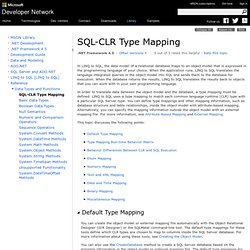

Hadoop: что, где и зачем. Развеиваем страхи, ликвидируем безграмотность и уничтожаем мифы про железнорождённого слона.

Под катом обзор экосистемы Hadoop-а, тенденции развития и немного личного мнения. Поставщики: Apache, Cloudera, Hortonworks, MapR Hadoop является проектом верхнего уровня организации Apache Software Foundation, поэтому основным дистрибутивом и центральным репозиторием для всех наработок считается именно Apache Hadoop. C# - Select Right Generic Method with Reflection. Documentation - winusbnet - WinUSB .NET wrapper library. MemMaker for the .NET Compact Framework - Rob Tiffany's Windows Mobile Accelerator. Visual studio - C# documentation generator?
Асинхронное программирование и Computation Expressions. Использование async и await в C# — лучшие практики / Хабрахабр. .NET Meanderings. Before WCF it was, of course, possible for software running on different machines to communicate.

Over the lifetime of Windows there have been many technologies to achieve this: sockets, DCOM, MSMQ, .NET Remoting, ASMX Web Services and more. The problem is all of these have different APIs and different levels of capability. The goal of WCF was to provide a unified API for communication and to be able to provide a common level of service irrespective of the underlying transport. Database object naming conventions (For SQL Server databases, tables, views, triggers, indexes, primary keys, foreign keys and constraints, cursors, stored procedures, user defined functions [UDFs], columns, defaults, variables): Narayana Vyas Kondreddi's.
NEW!!!
![Database object naming conventions (For SQL Server databases, tables, views, triggers, indexes, primary keys, foreign keys and constraints, cursors, stored procedures, user defined functions [UDFs], columns, defaults, variables): Narayana Vyas Kondreddi's](http://cdn.pearltrees.com/s/pic/th/conventions-constraints-16867746)
Subscribe to my newsletter: There exist so many different naming conventions for database objects, none of them is wrong. It's more of a personal preference of the person who designed the naming convention. However, in an organization, one person (or a group) defines the database naming conventions, standardizes it and others will follow it whether they like it or not. I came up with a naming convention which is a mixture of my own ideas and views of SQL experts like Joe Celko! This article references Microsoft SQL Server databases in some examples, but can be used generically with other RDBMSs like Oracle, Sybase etc. too. Tables represent the instances of an entity. So, name your customer table as 'Customers'.
Delegates and Events—Asynchronous method calls at C. Another useful feature of delegates is the ability to execute a method asynchronously.

That is, through a delegate, you can begin invocation of a method and then return immediately while the delegate executes its method in a separate thread. The following example demonstrates the use of delegates for asynchronous method invocation. To see this in action we need a method that simulates a lengthy operation, such as flushing data to disk. Below is a class named DataCache, which may periodically need to write its cache to a file. The class contains a method named FlushToDisk to simulate this operation. class DataCache { public int FlushToDisk(string fileName) { // simulate a long operation Thread.Sleep(4000); return 0; } } Since writing to disk is an expensive operation, we would like execute the FlushToDisk method asynchronously. The generated EndInvoke method is defined to return the same type as the asynchronous method. First we look at polling. B# .NET Blog. With the recent release of the Reactive Extensions for .NET (Rx) on DevLabs, you’ll hear quite a bit about reactive programming, based on the IObservable<T> and IObserver<T> interfaces.

A great amount of resources is available on Channel 9. In this series, I’ll focus on the dual of the System.Reactive assembly, which is System.Interactive, providing a bunch of extensions to the LINQ Standard Query Operators for IEnumerable<T>. In today’s installment we’ll talk about EnumerableEx’s facilities to tame side-effects in a functionally inspired manner: Being rooted in query comprehensions as seen in various functional programming languages (including (the) pure one(s)), one would expect LINQ to have a very functional basis. Создание динамического прокси-объекта с помощью dynamic типа. Как и многие люди, перед которыми стоит задача написания очередного UI для своего приложения, я периодически сталкиваюсь с необходимостью создания для UI своей собственной модели, которая в какой-то мере повторяет модель предметной области, однако при этом расширяем и/или изменяет ее.

И вот что из этого вышло. Постановка задачи Например, у нас есть класс Region такой структуры public class Region{ public string Name { get; set; } public int Index { get; set; } public IEnumerable<Region> SubRegions { get; set; }}* This source code was highlighted with Source Code Highlighter. И есть задача показать пользователю в UI дерево регионов, построенное по этой модели, а так же дать возможность выбрать определенные регионы, которые подлежат какой-то дальнейшей обработке.
Public class RegionViewModel{ public Region Value { get; set; } public IEnumerable<RegionViewModel> SubRegions { get {/*...*/ } }}* This source code was highlighted with Source Code Highlighter. Monotouch и Monodevelop. Программируем для iOS на C# на примере нашего проекта. Часть III.: Понемногу о программировании.
Интересные вещи, которые можно делать с dynamic в .NET 4.0 / .NET. ORM Comparison and Benchmarks on ORMBattle.NET. The Scala Programming Language. SQL-CLR Type Mapping. In LINQ to SQL, the data model of a relational database maps to an object model that is expressed in the programming language of your choice.

When the application runs, LINQ to SQL translates the language-integrated queries in the object model into SQL and sends them to the database for execution. When the database returns the results, LINQ to SQL translates the results back to objects that you can work with in your own programming language. This topic discusses the following points: Because of differences in precision and execution between the CLR and SQL Server, you may receive different results or experience different behavior depending on where you perform your calculations.
Calculations performed in LINQ to SQL queries are actually translated to Transact-SQL and then executed on the SQL Server database. For example, the following are some differences in behavior between the CLR and SQL Server: SQL Server orders some data types differently than data of equivalent type in the CLR.